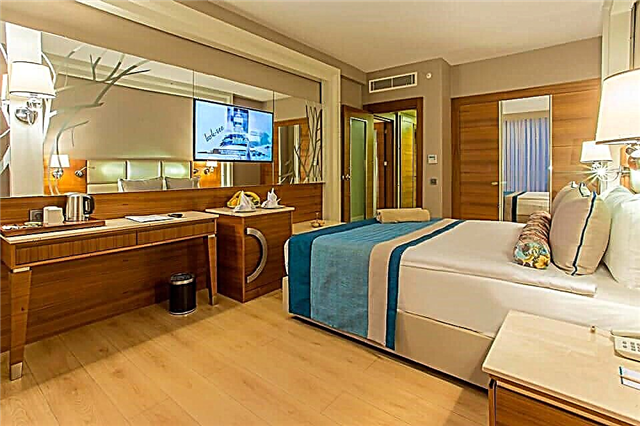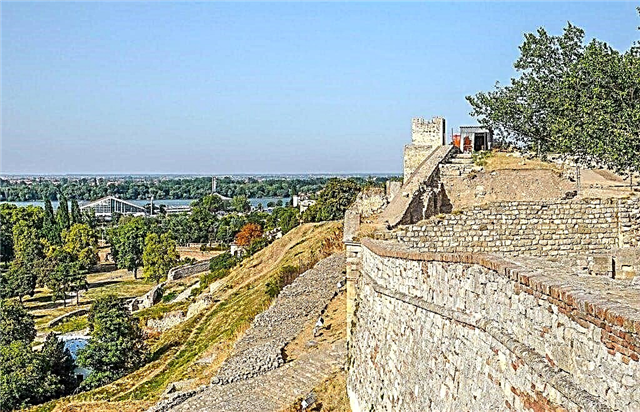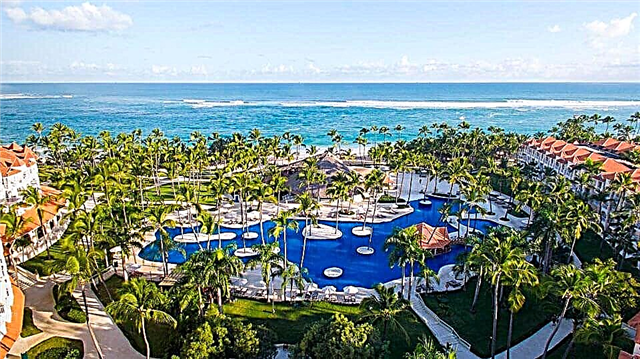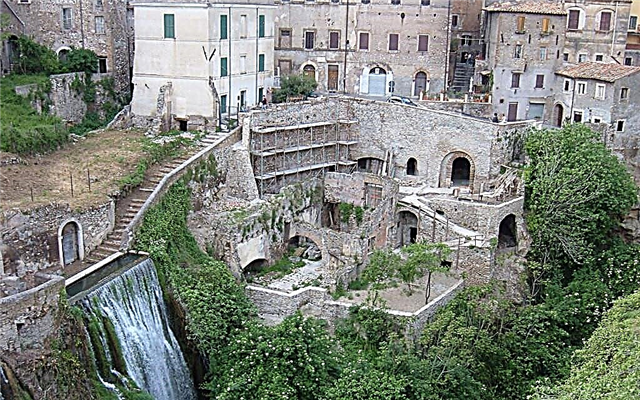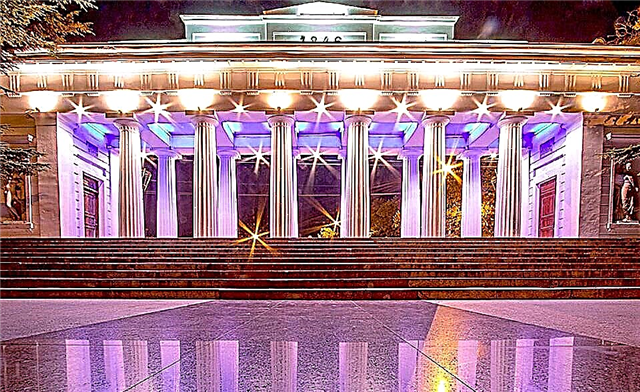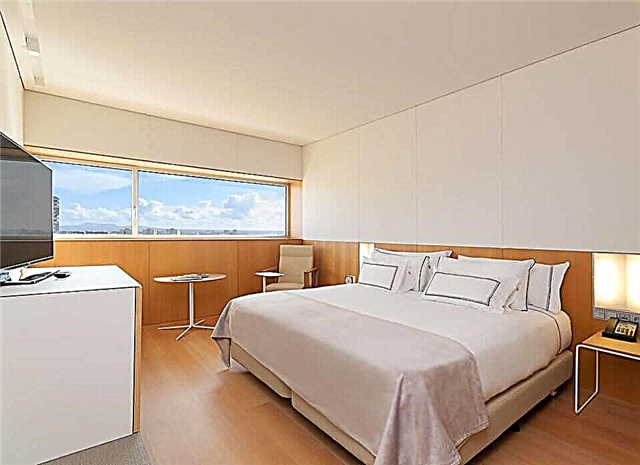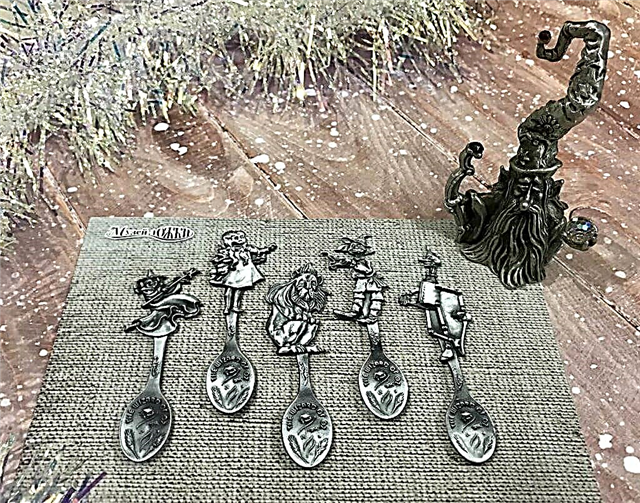In 1108, a fortress appeared on the banks of the Klyazma, which laid the foundation for the white-stone Vladimir. For many years this city was an important political and Orthodox center of Russia. He was honored by the great princes - Andrei Bogolyubsky, Vsevolod the Big Nest, Alexander Nevsky and Yuri Dolgoruky, and Andrei Rublev worked on the decoration of the main cathedral. Until the time of the Middle Ages, Vladimir competed with Moscow.
Today, silent witnesses of a thousand-year history can be found in every corner of the ancient city. In 1992, the main attractions of Vladimir (Golden Gate, Dmitrievsky and Assumption Cathedral) took their rightful place in the UNESCO World Heritage List. However, these unique objects are only a small part of the architectural and cultural monuments that are worth visiting for the guests of the pearl of the Golden Ring of Russia.
Cathedral Square

In the very heart of the city lies Cathedral Square, named so because of the nearby Dmitrievsky and Assumption Cathedrals. In its lifetime, this place has seen many events. Veche took place here, prayers were read, militias gathered, rallies were held. In the 18th - 19th centuries, the “Vladimirka” stretched across the square - the road along which, thundering with shackles, thousands of convicts went to Siberia.
The stylistic center of Cathedral Square is a monument erected for the 850th anniversary of the city, which is an impressive 22-meter truncated pyramid. At its foot sit bronze figures of a warrior, architect and worker. As conceived by the authors, the sculptures should symbolize Vladimir's past and present. The people, however, judged differently: the locals call the monument nothing more than "Three fools" or "Three lazy people".
Like hundreds of years ago, today the cozy Cathedral Square is the center of public life. Folk festivities are held here, city and state holidays are celebrated on a grand scale. On New Year's Eve, a merry Christmas fair convenes guests, and a tall spruce tree shines with multi-colored lights next to the House of Friendship.
Assumption Cathedral

For more than 850 years, the five-domed Assumption Cathedral flaunts on the banks of the Klyazma. Its founder, Andrei Bogolyubsky, dreamed of building the most magnificent church in Russia. His Serene Prince's wish came true. The white-stone building shining with golden domes, for the construction of which the best architects came together, rushed up to 32.3 m, thereby surpassing the Kiev St. Sophia Cathedral.
The grandiose temple was rebuilt several times. But even after numerous reconstructions, it amazes with the elegance of stone carving, semicircular facade capitals and portals made of gilded copper sheets. The interior also looks amazing. For nine centuries, the colors of the priceless frescoes by Andrei Rublev and Daniila Cherny have not faded. No less impressive are the intricate stucco moldings, luxurious chandeliers and the iconostasis that goes under the arches.
Not only believers can visit the magnificent monument of ancient Russian architecture. The church is open daily (except Mondays) from 10:00 to 17:00. The porches and the middle part of the cathedral, as well as the necropolis where Andrei Bogolyubsky with his sons Izyaslav and Gleb and other princes are buried, are available for inspection. During services for tourists, the temple is closed.
Dmitrievsky Cathedral

The initiator of the construction of the Dmitrievsky Cathedral was Vsevolod the Big Nest. In 1194, the Grand Duke wished to build a church in his courtyard to the glory of St. Demetrius of Thessaloniki - the heavenly patron of the lord. Until 1917, prayers and services were held in the church. After the revolution, the house of God became the property of the Vladimir Museum, under whose wing it is located to this day.
For the abundance of patterned stone reliefs, the Dmitrievsky Cathedral was named “the white stone book”. Hundreds of images of historical figures, mythological creatures, biblical heroes and heraldic symbols adorn the three-tiered facade. The interior decoration surprises with the restraint of lines and the absence of pompous details. The ascetic walls are set off only by a domed openwork 4-meter cross and several preserved icons and frescoes of the 12th century.
The main treasures of the temple are a chased silver reliquary with pieces of St. Demetrius of Thessaloniki and the icon of the saint. The image of the great martyr sitting on the throne, dressed in red princely robes, was created by Byzantine craftsmen in the 12th century. The relic is not the original: the original is kept in the Moscow Tretyakov Gallery.
Golden Gate

During the reign of Andrei Bogolyubsky, Vladimir was surrounded by a fortress ring, which had seven gates. Only one guardians of the ancient city have survived to this day - the Golden Gate, built in 1164, whose oak frames were covered with gilded copper sheets shining in the sun. For four centuries, noble princes, preparing to ascend the throne, passed through the triumphal arch.
The Golden Gate served not only as a front entrance - it served as a bastion. During the siege of 1238, Batu's army found it impossible to storm the impregnable fortress and attacked Vladimir from the side of the city walls. By the way, the locals, preparing for the defense, hid the gilded plates that adorned the gates from the enemy. The priceless relic has not yet been found.
In Soviet times, the KGB archives were located inside the building. In the mid-90s of the XX century, icons of the Savior and the Virgin Mary reappeared above the arch. Today, an outstanding creation of ancient architects keeps the rarities of the Military Historical Exposition. In the upper part of the building, there are samples of weapons from different times and a diorama depicting the assault of Vladimir by the Mongols.
Historical Museum

The idea of creating an exposition introducing the history of the native land belonged to the secretary of the Vladimir provincial committee Tikhonravov. Through the efforts of an ethnographer and with the support of local philanthropists in 1869, a collection of 300 items was placed in one of the halls of the men's gymnasium. The Historical Museum received its own building, located not far from the Dmitrievsky Cathedral, only in 1906.
The construction itself is worthy of attention, within the walls of which artifacts collected over many years are stored. Built in the pseudo-Russian style, the two-story red-brick building resembles a boyar's tower. Inside there are archaeological finds, frescoes, icons, weapons, coins, clothes, household items and archival documents telling about the stages of the formation of the Vladimir region - from ancient times to the beginning of the 20th century.
The exhibits on display will appeal not only to local residents. Anyone who is not indifferent to the history of Russia will be interested to see the tools of labor of the primitive Sungir people, and the casket with decorations of the 12th century discovered in 1993, and samples of the fonts of the illegal printing house of the RSDLP. The collection can be viewed daily from 10:00 to 17:00. Day off - Wednesday.
Vladimir Central

Those who have ever heard the songs of Mikhail Krug are familiar with the name of the notorious Russian prison. "Vladimirsky Central", the construction of which cost the provincial treasury 145 rubles, opened its inhospitable doors in 1783. According to the will of Empress Catherine II, recidivists and dangerous criminals were the first to be imprisoned in casemates. At the beginning of the 20th century, the prison turned into a political isolator.
At one time, revolutionary Mikhail Frunze, writer Daniil Andreev, actress Zoya Fedorova, singer Lydia Ruslanova and Stalin's son Vasily Iosifovich visited the dungeons. Today's Vladimirsky Central is a special regime prison. Convicts for murder, violence and robbery get into her cells. Most of the prisoners are sentenced to long terms or life imprisonment.
In 1996, an exposition was opened in the state house, introducing the fate and simple life of prisoners: personal belongings, homemade playing cards, figurines made of bread, photographs and drawings of convicts. To enter the prison, visitors had to obtain special permission. The museum is currently inaccessible to tourists.
Museum Center "Chambers"

A stone's throw from Cathedral Square is an imposing three-story building, built in 1790 in the classicism style. Snow-white semi-columns, granite steps, pilasters and an openwork fence make it look like a palace. Until 1993, the "Chambers" served the needs of the provincial and then regional administration. Today, various exhibits of the Museum Center are exhibited in the ceremonial halls.
The lower floor is occupied by a children's section. Young fans of history and art can find themselves in the past, visit the land of toys and travel to different cities of the planet. One floor above is the Art Gallery - a collection of icons, copies of frescoes from Vladimir churches and paintings by Russian artists of the 18th - 20th centuries. An exposition shedding light on the estate life of the Vorontsov and Khrapovitsky families is also presented here.
In addition to permanent and temporary exhibitions, the complex invites its guests to become participants in cultural and entertainment programs. The museum regularly puts on theatrical performances, organizes children's and family holidays, lectures, and thematic evenings. The "Chambers" are open for visitors from Monday to Saturday. Working hours: from 10:00 to 17:00.
Museum "Old Vladimir"

Looking at the unusual three-tiered building, built according to the canons of the pseudo-Russian style, it is hard to believe that it was originally intended for the needs of the city water supply system. The red-brick walls, high windows, cornice rollers and pointed arches of the water tower, erected in 1912, look too elegant and solemn.
The tower performed its main function until the 50s of the last century. In 1971, the dilapidated building was restored, and four years later a museum was housed in it. About 800 exhibits reveal the pages of the city's everyday life at the end of the 19th - beginning of the 20th centuries: what advertisements were printed in the marriage newspaper, what women of fashion wore, how the shops delighted customers and what performances were given in theaters.
In addition to everyday and cultural artifacts, the collection includes complete ensembles. So, here you can see a typical inn, a church shop and a police station. On the top floor, where the water reservoir used to be, there is an observation deck covered with a tent. From here spreads a majestic panorama of the city with its white-stone cathedrals, historical buildings and boundless Zaklyazmen open spaces.
The exhibitions are available from 10:00 to 18:00 (Tuesday-Sunday) and from 10:00 to 19:00 (Saturday).
Museum "Crystal. Lacquer miniature. Embroidery"

In 1916, not far from the Golden Gate, a brick Trinity Church appeared, the construction of which was timed to coincide with the 300th anniversary of the Romanov family. The last liturgy in the Old Believer Church, nicknamed by the people "Red", was served in 1928. In 1974, a museum was opened within its walls, which stores wonderful handicrafts.
Amazingly beautiful works can be created not only by Murano wizards. Russian glassmakers are not bastard either. This fact is confirmed by the fragile creations of craftsmen from the city of Gus-Khrustalny. Showcases installed under vaulted ceilings sparkle and shimmer with colorful vases, wonderful goblets, carved glasses, sumptuous dishes and graceful figurines. Works made in the 18th century are of particular value.
The second part of the museum's treasures is the caskets decorated with miniature lacquer painting. And in the rooms previously occupied by church choirs, samples of fabric with intricate designs are exhibited without a face or a seamy side. This is Mstera embroidery - a unique type of folk applied art, which began in the 18th century by novices of the monastery of St. John the Merciful. You can admire the beautiful collection every day (except Tuesday) from 11:00 to 19:00.
Monument to Prince Vladimir and Saint Fyodor

In 2007, a significant date was celebrated in the ancient city - the 850th anniversary of the transfer of the capital of the Russian land from Kiev to Vladimir. And it is not surprising that the grand opening of the monument to the baptists of the Vladimir-Suzdal principality: Vladimir Svyatoslavovich (Red Sun) and St. Fyodor (Archbishop of Rostov) was timed to coincide with this event.
The sculptural composition by Sergei Isakov and Sergei Gerasimov rises on the observation deck of Pushkin Park, from where a picturesque panorama of the city opens. On a pedestal, surrounded by bas-reliefs with the names of historical characters and images of saints, Prince Vladimir sits on a war horse. A banner with the face of the Savior flies over the head of the Baptist of Russia dressed in military armor.
Beside the Equal-to-the-Apostles prince stands Saint Theodore, dressed in the clothes of the Metropolitan. The archpastor, thanks to whom the pagans of Suzdal and Rostov adopted the Orthodox faith, holds the Holy Scripture in his left hand; the fingers of the right are folded in a blessing gesture. The gaze of both baptists is turned to the full-flowing Klyazma.
Central Park of Culture and Leisure

The largest park in the city, founded in 1951, covers an area of 15.5 hectares. Until the beginning of the 21st century, most of the local territory was a green area. After the renovation in 2015, new lanterns, paved paths and neat lawns appeared here. Outdated pavilions and sculptures of the Soviet era were replaced by entertainment centers and art objects.
Birch and linden alleys stretch from the main entrance located on Mira Street. Walking paths and bicycle paths are laid between dense trees, here and there are comfortable benches. In the City of Attractions, there are carousels for big and small: from swing boats to a giant Ferris wheel. An open-air café is open during the warmer months.
Park entertainment is not limited to walks along shady alleys and ride on carousels. There is a recreation center, a tennis court and a football field popular among the residents of Vladimir, where the city mini-football championship starts in summer. Concerts, holidays, social and political events are held on the open stage opposite the fountain.
Ferris Wheel "Sky33"

Vladimir with its ancient buildings, endless Opolye and boggy Meshchera forests is one of the most beautiful places in Russia. There is something to admire in the city and its environs, so there are enough viewing platforms here. The best views are from the cabins of the Ferris wheel installed next to the Central Park fountain.
The height of 50 m makes "Nebo33" one of the largest Ferris wheels in Russia. You can enjoy the 15-minute ride in any weather - each of the 32 transparent cabins is equipped with a split system that maintains a comfortable temperature. Those wishing to see the city in detail can use binoculars. Tourists who decide to ride the attraction after sunset, when the giant structure is illuminated by hundreds of iridescent lights, will get even more impressions.
An exhibition pavilion is located next to Nebom33. Inside there is an unusual 16 m² exposition, which is a model of the historical and central part of Vladimir. It took about one year to create churches, monasteries and old houses made with jewelry precision. A souvenir shop is open next to miniature city objects.
Planetarium

On Bolshaya Moskovskaya Street, there is the Nicholas Kremlin Church, which has a history of more than 250 years.Once in a yellow-white building, crowned with an onion dome, liturgy was served and prayers were offered to St. Nicholas the Wonderworker. Today, the former temple houses a planetarium opened in 1962.
There is a small museum in the lobby, where exhibits such as the Foucault pendulum and models of artificial earth satellites are kept. Then visitors enter the observation room, on the dome of which circular pictures of Martian troughs and lunar craters come to life. Planetarium employees do not disregard any event of a "universal scale". A solar eclipse, a parade of planets, a meteor shower - all these phenomena appear before the eyes of the guests of the "Star House".
The planetarium is not only a museum exposition and viewing of "heavenly" films. Here they give lectures on cosmonautics, astronomy and geography, hold musical evenings and organize
Exhibitions. You can learn the secrets of the Universe and take part in interesting events on weekdays from 08:45 to 17:15, on Saturdays - from 10:00 to 14:00. Sunday is a day off.
Puppet Theatre

In 1967, a puppet group was added to the collective of the Vladimir Regional Philharmonic Society, which two years later laid the foundation for a new theater. In 1973, the Melpomene temple received its own building, located on Gagarin Street. However, the building, built at the beginning of the 20th century, required a thorough reconstruction, so for the first time the curtain of the youngest city theater rose only in December 1977.
Since then, more than 150 performances have been performed on the cozy stage. The repertoire is based on fairy tales of the peoples of the world, works of foreign and Russian classics, works of authors of modern literature. Little viewers have already met with the strict Moidodyr, and with the resourceful Ali Baba, and with the mysterious Aelita. In addition to puppets, live actors often take part in performances.
The troupe's activities are not limited only to showing performances. Creative workers regularly hold meetings, arrange exhibitions, participate in regional and all-Russian art festivals. School Days are gaining more and more popularity, during which young people from Vladimir try their hand at decorating theater corners and writing scripts.
Friendship house

The two-story brick-built building on Bolshaya Moskovskaya Street invariably attracts attention. The eye rejoices when you look at the keeled platbands, carved cornices, triple arches and an angular turret crowned with a weather vane. The creator of the building, built in 1907, was the architect Yakov Revyakin. The architect is especially proud of two richly decorated tents, towering over a hipped roof.
The building, which looks like a fabulous Russian tower, before the revolution served as a home for the City Duma, an orphan's court and an insurance company, which occupied the top floor of the building. Below there were shopping arcades. After 1917, the premises that previously belonged to officials and merchants were transferred to the Council of People's Deputies, and then to the Palace of Pioneers.
In 1985, the students were moved to a new building. The halls of the former City Duma were empty for 20 years, gradually falling into decay and requiring large-scale renovation. The lengthy renovation was completed in 2008. After the restoration, the House of Friendship was opened here, where today concerts are held, guests of honor are received, negotiations and awards ceremonies are held.
Church of the Holy Rosary of the Blessed Virgin Mary

The only regional representative of the Catholic Church - the pseudo-Gothic Church of the Holy Rosary - is located on Gogol Street. It owes its appearance to former soldiers of the Polish-Lithuanian regiment, transferred to Vladimir from the territory of the Russian lands of the Kingdom of Poland. The temple, built at the expense of the settlers, was consecrated in 1894.
The brick church consists of three parts: the bell tower, the altar and the main room. The entrance is preceded by a multi-tiered tower with pointed windows. The interior decoration differs from the luxurious interiors of large Catholic churches: austere white walls, rows of wooden benches, several wall paintings and a golden crucifix over the throne open to the eyes of the parishioners.
After the revolution, the Church of the Holy Rosary suffered the fate of the majority of Russian churches. In 1930, the parish was closed, and in the 70s, expositions of the Vladimir-Suzdal Museum were placed in its premises. The temple was returned to the parishioners in 1992. Nowadays, not only liturgies are served here, but organ music concerts are also organized.
Museum "Old Pharmacy"

In an old house on Georgievskaya Street, where a city pharmacy was opened in the 19th century by the order of the governor, exhibits of a pharmaceutical museum are exhibited today. The ancient walls are decorated with archival documents and photographs. On authentic shelves and tables, a variety of beakers, test tubes, burners, flasks and vials are lined up in neat rows.
The museum has three rooms. In the main hall there are cash registers, rare scales, medical brochures. In the pharmacist's office, there are medical cases, a wardrobe, ancient abacus and a cage with a canary. The atmosphere of an old rich house is recreated by a small fireplace room filled with luxurious European furniture, ornate mirrors and painted shades.
In addition to the permanent collection, the exposition includes products from one of the oldest Italian pharmacies, Santa Maria Novella. The history of the Perfume and Pharmaceutical House, opened by the Florentine monarchs, is more than 400 years old. The museum also has its own phytobar, which sells herbal infusions, medicinal teas and cosmetics.
Working hours: Tuesday – Sunday from 10:00 to 19:00.
Drama theatre

A veteran of the cultural life of Russia - the Vladimir Drama Theater - appeared in 1848. Its founders - actor Ivan Lavrov and entrepreneur Boris Solovyov - managed to convince the governor of the need to create their own temple of Melpomene in the provincial city. The first performances took place on a simple wooden stage, the audience sat on hastily knocked down benches.
The popularity of the young theater grew rapidly: the troupe performed not only within its native walls, but also actively toured the country. In 1905, the team celebrated a housewarming by moving to the People's House. During the Great Patriotic War, the actors changed the stage to an impromptu front-line stage, forming a mobile theater team.
A striking event in the life of the Drama Theater was the move to a new building on Dvoryanskaya Street, where it flourishes to this day. On the local stage, they are not limited to staging plays by Russian and foreign authors. In 2020, the festival "At the Golden Gate" started here for the sixth time, for the main award of which teams from the best Russian theaters fought.
Theotokos-Rozhdestvensky monastery

For many centuries, the Nativity of the Mother of God Monastery, founded by Vsevolod III in 1191, remained the Orthodox center of Russia. Until the 14th century, there was a metropolitanate in the monastery, and in 1722 - the first digital school in Vladimir. In the bosom of the shrine, Alexander Nevsky found rest, whose relics under Peter I were transferred to the Alexander Nevsky Lavra.
The ancient monastery is called the "Vladimir Kremlin" by the locals. Behind a high wall, built of white stone, there is a whole complex of structures that have preserved their late medieval appearance. The focus of the monastery's spiritual life is the Cathedral of the Nativity of the Mother of God, next to it is the Alexander Nevsky Cathedral and the Holy Gates. From the western part, brotherly cells and bishops' chambers stretch in a long line to the churches.
The Soviet era became the time of sunset for the monastery. For 70 years, the Office of the GubChK, KGB and NKVD services were located here. During the years of Stalinist repressions, enemies of the people were shot within the holy walls. The revival of the architectural ensemble began after the collapse of the USSR. In 2004, the Cathedral of the Nativity of the Virgin, destroyed by the Bolsheviks, was erected, and two years later - the bell tower. The ancient monastery became active again.
Holy Dormition Princess Convent

In 1200, the wife of Vsevolod III Maria founded the Holy Dormition Monastery. After her death, the monastery became the last refuge of the female half of the grand ducal house. The first to be buried in the tomb was Mary herself, who, a few days before her death, received the schema with the name Martha. The children and wives of Vsevolod III and Alexander Nevsky are also buried here.
The fate of the monastery cannot be called easy. In its long life, it survived several devastating fires and the treacherous invasion of the Tatars in 1411 and 1238. In 1923 the monastery was abolished. The novices found themselves on the street, property was confiscated in favor of the state. The monastery returned to the bosom of the church in 1992. The sisters settled in the cells again.
The spiritual center of the Princess of the Monastery is the Assumption Cathedral, for the painting of which the best Moscow icon painter Mark Matveyev was invited. His colorful works - "The Last Judgment", the frescoes of the columns, the altar arch and the Akathist have survived to this day. Two of the greatest shrines are kept within the walls of the temple: the miraculous icon of the Mother of God of Bogolyubskaya painted in the 12th century and a cancer with the relics of the martyr Abraham the Bulgarian.
Patriarchal Garden

There is a legend that the history of one of the most picturesque places in Vladimir began in the 12th century. Andrei Bogolyubsky, who wanted to break a fragrant oasis next to his tower, brought cherry seedlings from Kiev. Since then, the cultivation of these fruit-bearing trees in princely courts and monasteries has become a tradition. Over time, the cherry itself has become a living symbol of the city.
The first archival documents mentioning the green zone date back to the 16th century. Since the well-groomed garden loved to honor the capital's clergy with their attention, it was named "Patriarchal". The park delighted local residents until the 30s of the XX century. Then the trees began to be ruthlessly cut down, and those that escaped the ax died from the cold. Fortunately, in 1948 a decision was made to restore the recreation area.
The modern Patriarchal Garden is an area of 2.5 hectares, where decorative and garden trees freely grow. There are about 100 species of them here. The center of the park is a multi-jet fountain with a stone staircase leading to it. In addition to plants, fragrant flowers, sculptures and alleys, the Station of Young Naturalists is located here. Its employees offer to take part in a tour of the picturesque arboretum.
Spoon Museum

It would seem, what can such a banal object as an ordinary spoon tell about? It turns out about a lot! This fact is confirmed by the Spoon Museum located on Oktyabrskaya Street. His collection, collected over 26 years, includes over 20,000 specimens: silver, bronze, wood, pewter, porcelain and even coconut. Not the entire fund is presented in the halls: visitors will see “only” 3,000 copies.
The historic and modern cutlery displayed in the display cases came from 150 countries around the world. There are Egyptian artifacts, coronation accessories of English monarchs, German "Hildesheim roses", Welsh spoons of love and American "Thumbnails" with fragments of Andersen's fairy tale carved on them. A separate stand is dedicated to the products of Vladimir manufacturers.
Themed excursions that shed light on the history, rituals, traditions and signs associated with the spoon will be an excellent addition to the collection. Master classes on serving, table etiquette and painting wooden spoons will help you take a fresh look at such a familiar thing. The museum is glad to see its guests every day from 11:00 to 18:00.
Gingerbread House Museum

The gingerbread house exists not only in the magic forest of the Brothers Grimm. A painted hut made of sweet cakes and dozens of other honey confectionery products of various shapes and colors are lined up in the windows of the Gingerbread Museum, which is located on Bolshaya Moskovskaya Street. All exhibits are prepared by Pokrovsk masters, using wooden print templates and food paint.
The collection of the museum introduces the history of the emergence of delicacies and the ancient rituals associated with these pastries. The hall, stylized as the royal chambers, displays stucco, carved, printed and silhouette gingerbread specimens, as well as amazing sweet paintings. And, of course, samovars of different sizes, because without them it is impossible to imagine Russian tea drinking.
The culmination of the excursion program is the holding of master classes immersed in the traditions of making delicacies. Here, everyone chooses an activity to their liking, whether it be painting a royal gingerbread, sculpting Pomor roe deer or creating a funny amulet doll. If you don't want to cook sweet masterpieces with your own hands, you can buy them in a souvenir shop.
Open from 10:00 to 19:00 (weekdays) and from 10:00 to 20:00 (weekends).
Forge-Museum of the Borodins

The workshop located on Georgievskaya Street belongs to the family of unusual exhibitions. Yuri Borodin, a hereditary blacksmith who participated in the restoration and decoration of dozens of city and regional museums, works here. His son Aleksey helps the master in the matter. Creating forged masterpieces, craftsmen use unique ancient technologies and traditions of their dynasty.
Like many years ago, the coals for "fiery work" in the Borodins' workshop are blown up with air heated to 1,500 ° C. On an anvil with two noses, blacksmiths create not just forged products, but real works of art. The workbenches display delicate figurines and delicate candlesticks, and the walls are adorned with impressive metallic flowers and decorative panels.
Unique items can be purchased as a souvenir, or you can make yourself. Feel in
hands with the weight of a hammer and make a nail from an iron bar invite master classes in blacksmithing. Frequent guests of the studio are newlyweds who forge horseshoes for good luck. The workshop is open to visitors on Saturdays and Sundays (from 10:00 to 18:00) and on Fridays (from 12:00 to 18:00).
Trinity Church

Trinity Church has been standing near the Golden Gate since 1912. The temple, which is popularly called "Red" for the bright color of the brick facade, appeared in the city thanks to the community of Old Believers merchants. The Old Believers timed the erection of the house of God to coincide with the celebration of the 300th anniversary of the reign of the Romanov family.
Among the many churches of Vladimir, Trinity Church stands out for its original appearance. In its appearance, the traditions of Russian architecture and the architectural techniques of Byzantium merged together. The main building and the adjoining bell tower are crowned with helmet-shaped domes. The red facade contrasts nicely with the white-stone window slopes, plinth and portal. The magnificent structure is decorated with whimsical belts and curtains.
Until 1928, services were held in the church. Then, by decree of the new government, which declared war on the Orthodox faith, the church was closed to parishioners. The archives bureau moved into the building. In 1960, the question arose about the destruction of the parish, and only thanks to the city activists the demolition was avoided. Today, the Trinity Church displays exhibits of the Museum "Crystal. Embroidery".
Nikitskaya church

The Nikitskaya Church stands alone in the architectural ensemble of the historic city center. The white-green building, bearing the characteristic features of the provincial baroque, was built in 1765 with the money of a wealthy merchant Semyon Lazarev. The patron of God dedicated the house of God to the memory of the Pereslavl miracle worker - St. Nikita the Stylite.
The original structure looked little like the building located today on the left side of the Golden Gate. Nikitskaya church acquired two borders, built at the expense of the soap-making magnate Pyotr Kozlov, in 1849. And the present appearance, with its high windows with baroque platbands, evoking the idea of palace buildings, the temple acquired at the end of the 19th century. This happened after the restoration, organized by one of the "fathers" of the city, Nikolai Filosofov.
After the events of 1917, the Soviet authorities repeatedly tried to close the parish, which happened in 1938.All three floors were occupied by restoration workshops. Believers again received access to the temple only in 2015. By the way, few people know that there is a small observation deck in the bell tower, where the episode of the film "Flights in Dreams and in Reality" was filmed.
Chocolate workshop

The main attraction for those who cannot imagine their life without sweets is located on Bolshaya Moskovskaya Street. The Chocolate Workshop is a popular place where it is always tasty, interesting and fun. Museum staff own all the information about the product loved by millions and generously share it with their guests.
Every self-respecting sweet tooth should know the whole story about the coveted delicacy. Therefore, the journey into the world of the Chocolate Workshop begins with a small excursion. The guide will reveal to its participants the secrets of the fragrant dessert; will tell you about the benefits of the product, the intricacies of its production and famous personalities who are not indifferent to chocolate.
Only handmade chocolate can be tastier than chocolate. During the master class, novice pastry chefs learn the basics of making first-class bars and sweets. In addition, in the museum you can celebrate a birthday, organize a party, complete a quest and, of course, buy sweets or order an outlandish chocolate fountain.
Working hours: from 10:00 to 19:00 (Monday-Friday) and from 10:00 to 20:00 (weekends).
Church of the Kazan Icon of the Mother of God

In 1782, a stone temple appeared in Yamskaya Sloboda, replacing the wooden Kazan Church. The building, erected in the provincial baroque style, was built using the latest engineering technologies at that time: there were no supporting columns, a closed brick vault consisted of eight blades.
In 1938, the services ceased. After 12 years, a screen was installed on the site of the altar, the faces of the saints were painted over, and a cinema was opened in the nave. In 1970, despite the admonitions of architects and local residents, the church was razed to the ground. The old masonry was so powerful that they had to destroy it with cast-iron bobbins and tanks. On the site of the destroyed temple, the authorities erected a Victory Monument.
The church experienced its rebirth at the beginning of the 21st century. The opening of a new parish with a gilded dome and a low bell tower took place in November 2008, on the day of honoring the icon of Our Lady of Kazan. Since then, the temple located behind the Victory Monument has been part of the memorial complex dedicated to the memory of those who died for the Motherland.
Prince Vladimir Church

In 1785, a church was erected on the territory of the city cemetery, named after the Baptist of Russia - Prince Vladimir, Equal to the Apostles. Funds for the construction were collected by the whole world. The place chosen for the parish was covered with many legends. According to one of them, before the Nativity of Christ, there was a pagan temple here, where the god Yarila was worshiped.
Prince Vladimir Church is the only city church built in the classicism style. The neat main building is devoid of external gloss: it is decorated only with a large green dome with one dome. The bell tower looks quite different. The grandiose three-tiered structure is decorated with pilasters, as well as friezes and patterned cornices lined up in several rows.
It is noteworthy that the services in the Prince Vladimir Church never stopped. Even in the dashing 1920s, when parishes were closed everywhere in Russia, and priests became victims of severe persecution, the doors of the church on Bolshaya Nizhegorodskaya Street were open to parishioners. Here and today prayers are read, liturgies are served, ceremonies and sacraments are held.
Scientific and educational center "Evrika"

All schoolchildren who consider physics lessons to be a boring pastime should visit the Eureka Center. About 150 exhibits will clearly show that there is nothing more interesting than electrodynamics, optics, mechanics and magnetism. The principle of the museum collection is to give new knowledge through experiments in which children and their curious parents take part.
There are more than enough objects for studying the surrounding world in "Eureka". Here you can touch a rainbow, check the electrical conductivity of your body, fire a lightning, play an electric guitar, draw in space, or sit on a chair with nails. And if there are still questions, the answers to them will be found in the 3D cinema, the room of gravity and the gallery of scientific illusions.
For young experimenters, the museum complex conducts master classes such as "The Magic of Color", "Spy Stories" and "Science in the Kitchen". Fascinating science shows will take place at Eureka every weekend. The topic is chemical and physical experiments. A cozy cafe awaits those who are hungry, and those who want to take unusual photos - funny optical attractions.
Center "Evrika" receives guests daily from 10:00 to 20:00.

